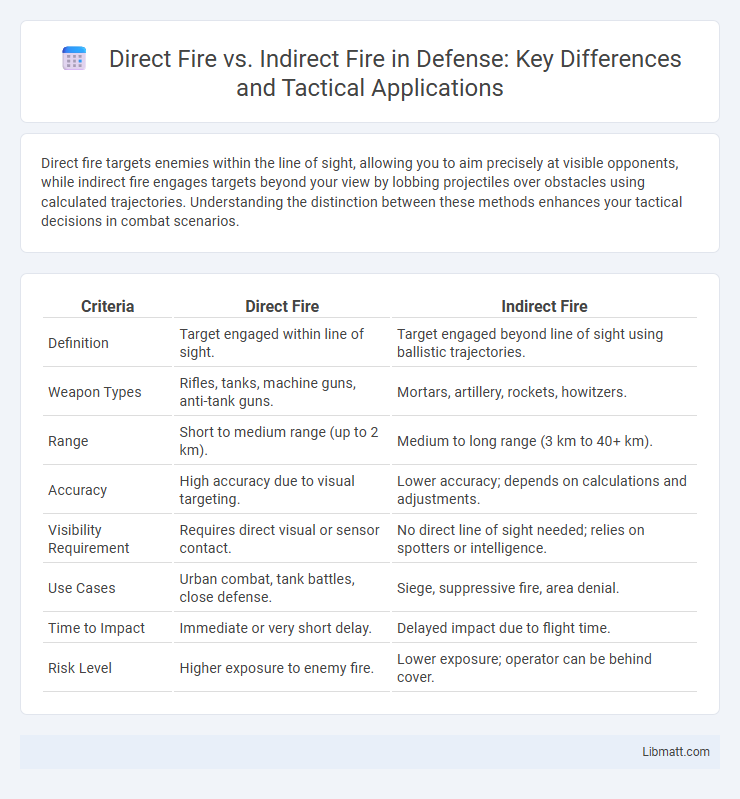Direct fire targets enemies within the line of sight, allowing you to aim precisely at visible opponents, while indirect fire engages targets beyond your view by lobbing projectiles over obstacles using calculated trajectories. Understanding the distinction between these methods enhances your tactical decisions in combat scenarios.
Table of Comparison
| Criteria | Direct Fire | Indirect Fire |
|---|---|---|
| Definition | Target engaged within line of sight. | Target engaged beyond line of sight using ballistic trajectories. |
| Weapon Types | Rifles, tanks, machine guns, anti-tank guns. | Mortars, artillery, rockets, howitzers. |
| Range | Short to medium range (up to 2 km). | Medium to long range (3 km to 40+ km). |
| Accuracy | High accuracy due to visual targeting. | Lower accuracy; depends on calculations and adjustments. |
| Visibility Requirement | Requires direct visual or sensor contact. | No direct line of sight needed; relies on spotters or intelligence. |
| Use Cases | Urban combat, tank battles, close defense. | Siege, suppressive fire, area denial. |
| Time to Impact | Immediate or very short delay. | Delayed impact due to flight time. |
| Risk Level | Higher exposure to enemy fire. | Lower exposure; operator can be behind cover. |
Understanding Direct Fire and Indirect Fire
Direct fire involves targeting an enemy or object within the shooter's line of sight, enabling precise aiming and immediate feedback. Indirect fire relies on artillery or mortar systems to strike targets beyond visual range, using calculated trajectories based on coordinates and adjustments. Understanding these distinctions helps you select the appropriate firing method for battlefield conditions and mission requirements.
Key Differences Between Direct and Indirect Fire
Direct fire involves targeting visible enemies with a straightforward line of sight, allowing for precise aiming and immediate adjustments. Indirect fire relies on launching projectiles at targets that are hidden or out of sight, using calculations and coordinates for trajectory. Understanding these distinctions helps optimize Your tactical approach in diverse combat scenarios, maximizing effectiveness.
Historical Evolution of Fire Support Methods
Direct fire and indirect fire have evolved significantly since ancient times, with direct fire initially dominating battlefield engagements through line-of-sight targeting using bows, muskets, and cannons. The development of indirect fire techniques emerged prominently in World War I, as artillery units began using ballistic trajectories and forward observers to engage enemy positions beyond visual range. Your understanding of modern fire support methods benefits from recognizing this shift, which fundamentally changed battlefield tactics by enabling precision strikes from concealed or protected positions.
Weapon Systems Used in Direct Fire
Direct fire weapon systems primarily include tanks, machine guns, assault rifles, and anti-tank guided missiles, each designed to engage targets within the operator's line of sight. These systems rely on precise aiming and rapid targeting to neutralize threats quickly on the battlefield. Your choice of direct fire weapons depends on the mission's range, target type, and required firepower.
Common Platforms for Indirect Fire
Common platforms for indirect fire include artillery systems such as howitzers, mortars, and multiple launch rocket systems (MLRS), which are designed to deliver firepower over long distances without a direct line of sight to the target. These platforms rely on advanced targeting data, including coordinates and elevation angles, often provided by forward observers or drones, to accurately engage enemy positions. Indirect fire platforms are essential in modern warfare for suppressing or neutralizing threats beyond the immediate battlefield, providing strategic support to ground forces.
Tactical Applications on the Battlefield
Direct fire involves engaging targets within the line of sight, offering precision and immediate feedback, making it ideal for urban combat and close-quarters engagements where accuracy and rapid target identification are crucial. Indirect fire is employed to strike targets beyond visual range using artillery or mortars, enabling suppression, interdiction, and area denial without exposing units to direct enemy fire. Tactical applications leverage direct fire for dynamic, responsive maneuvers against visible threats, while indirect fire provides strategic depth, shaping the battlefield by targeting enemy positions, supply lines, and fortifications from concealed or distant locations.
Advantages and Disadvantages of Direct Fire
Direct fire offers greater accuracy and immediate target engagement since the shooter maintains a clear line of sight, making it ideal for close to medium-range combat scenarios. However, it exposes the shooter to enemy detection and return fire, increasing vulnerability and limiting tactical flexibility. Your choice of direct fire depends on the operational environment where precision and rapid response outweigh the risk of exposure.
Strengths and Limitations of Indirect Fire
Indirect fire enables engagement of targets beyond the line of sight, offering strategic advantage by striking concealed or distant enemies with artillery, mortars, or rockets. Its strength lies in flexibility and force multiplication, allowing units to deliver accurate long-range fire without exposing personnel to direct enemy fire. Limitations include reliance on precise targeting data, time delays for adjusting fire, and vulnerability to counter-battery detection or unfavorable terrain affecting projectile trajectory.
Modern Innovations in Fire Support
Modern innovations in fire support have enhanced the precision and flexibility of both direct and indirect fire systems through advanced targeting technologies such as laser-guided munitions and networked battlefield sensors. Integration of real-time data sharing via digital command and control platforms enables rapid adjustment of fire trajectories, improving accuracy and reducing collateral damage. Autonomous and remotely operated weapon systems further increase effectiveness by allowing precise engagement in complex environments without exposing personnel to direct threats.
Choosing the Right Fire Method for Mission Success
Selecting the appropriate fire method directly impacts mission success by balancing accuracy and tactical advantage; direct fire offers precise targeting with visual confirmation, ideal for engaging visible threats at close to medium range. Indirect fire allows you to strike enemy positions beyond line of sight, using ballistic trajectories and coordinates, essential for suppressing fortified or concealed targets from a safe distance. Understanding terrain, target visibility, and operational objectives ensures your choice between direct and indirect fire maximizes combat effectiveness and minimizes risk.
Direct fire vs Indirect fire Infographic

 libmatt.com
libmatt.com